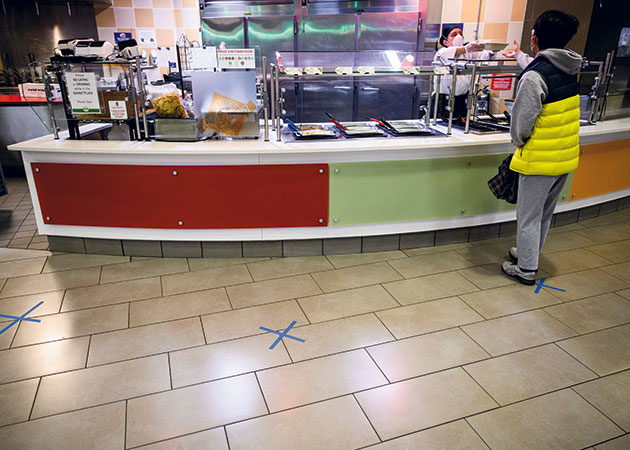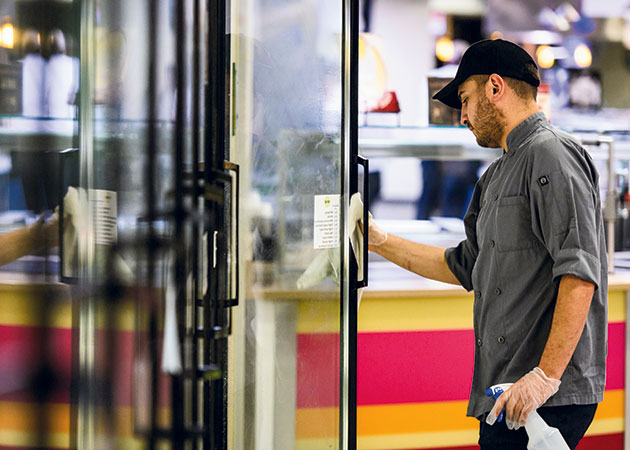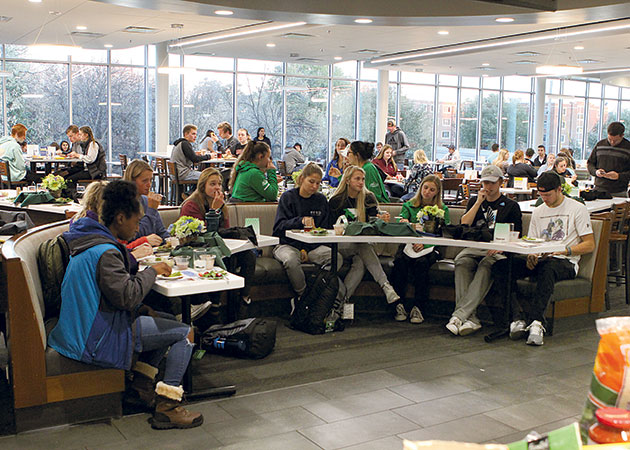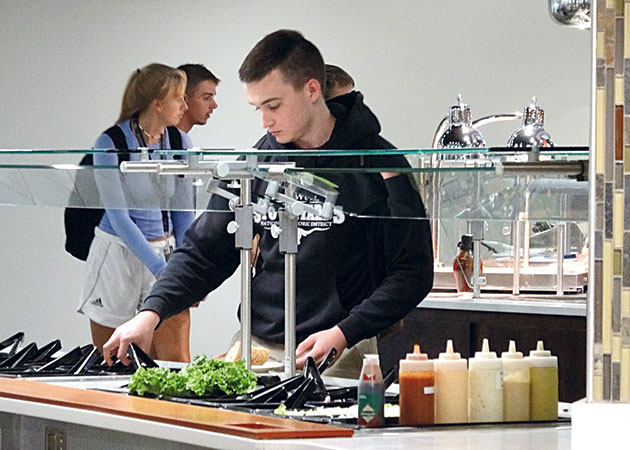With COVID-19 upending everything and fall semester fast approaching, questions about what’s next loom large for most of the nation’s college and university dining programs. The biggest and most immediate of those: Will there be students and staff physically on campus to feed?
It’s a question that would have seemed incredible to ponder earlier this year. Now, just a couple of months away from when the vibrant buzz of campus life would normally resume, full of excitement and comfortable predictability, it’s a question that even some of the largest and most esteemed institutions of higher learning are struggling to answer. After all, the nature of traditional campus life, with its crowded lecture halls and seminars, communal dining halls and study lounges, and large sporting and arts venues, makes returning to normal impossible, at least in the short term. With the coronavirus still a major public health threat, rapid paradigm shifts to remote learning and contactless operations dominate. In their wake is an unprecedented level of uncertainty about enrollment in general and about what to expect for on-campus life in particular.
It’s that life, of course, which determines the need for and ultimate nature of new-normal campus dining. Significantly fewer people to feed and choked-off revenue streams are already stark realities, introduced in a relative nanosecond in March as campus closures and shifts to e-learning quickly took effect. Working with skeleton crews and transitioning many of their own team members to remote working scenarios, dining directors rapidly shut down facilities, eliminated self-service and dine-in options, and pivoted to exclusively contactless and off-premises meal services for the few students and staff members remaining on campus. They also began confronting an urgent need to shift their own program paradigms in significant ways for the foreseeable future.
Many admit that planning for this has been akin to fumbling around in a dark room. Existing disaster preparedness strategies aside, none had sufficient playbooks in place for dealing with the impact of a pandemic the size, scope and likely duration of COVID-19. And a high level of uncertainty promises to stretch well into the summer, if not longer, as schools defer reopening decisions, grapple with testing, contact tracing and social distancing scenarios, and/or plan for continued remote learning. Dining programs that relied on big data to help set strategy in the past few years now have precious little solid information on which to base decisions.
A Stunning Scenario
Yale University took early signs from China in late 2019 and begin evaluating pandemic response plans used by the institution during the SARS and H1N1 epidemics. “Because of our previous work around those outbreaks, we knew that any kind of virus that begins its transmission as human to human, not animal to human, is one of those ‘holy crap’ moments,” notes Rafi Taherian, associate vice president of Yale Hospitality. “Over the past 20 years, we had trained ourselves to watch for that. When it happened, there was some conversation on our campus among various constituencies about what if it actually gets out. We began forecasting some scenarios, but initial data was very, very limited. Fast forward to March, and our university was asking us to have very specific plans for when it hits the U.S. in large numbers. I spoke with a number of foodservice industry leaders at a conference in early March, and it seemed it was hardly on their radars. I hoped that they were right, and we were overthinking things, but within two weeks the world literally turned upside down. It hit us like a baseball bat.”
Within the span of a couple of days, during Yale’s spring break, students were asked not to return to campus, residence hall evacuations began, social distancing protocols were implemented, and Yale Hospitality quickly switched gears to provide support and services for students unable to leave and staff still working on campus. Dine-in service was discontinued, retail foodservice outlets shut down and floors in any open facilities were marked to provide social distancing guidance. Centers for Disease Control experts had yet to recommend it, but Yale Hospitality made hand sanitizer available at all locations and required all staff members to wear masks and gloves and to change gloves frequently.
By late March, only the Yale Culinary Support Center remained open to produce and provide takeout meals for pickup. That facility also supplied meals to six additional stations set up as pickup points, a strategy deployed to reduce the amount of foot traffic and exposure among people across campus.
Through the balance of spring semester, Taherian estimates Yale Hospitality, which normally serves more than 11,000 students each day, served roughly 250 students and another 50 non-students daily. With many students unable to travel home, he anticipates his department will continue to provide the same sort of limited service through the summer months, while a variety of service-model scenarios are being considered for fall and beyond. According to a statement posted by Yale University president Peter Salovey in early May, decisions about reopening campus could be deferred until early July.
Peter Testory, director of dining and culinary services at the University of Wisconsin’s flagship campus in Madison felt as if his operation had been hit by the same baseball bat as Taherian’s. “We had disaster planning documents that were created during the H1N1 outbreak, so we started with those. But they became not useful within about 12 hours,” Testory says. “We went from implementing their high-level sanitation guidelines — mainly sanitizing touch points more often, particularly in our self-serve operations — to literally 72 hours later closing dining rooms, removing all self-service, packaging everything to go, enforcing strict social distancing and having most of the residence hall students gone.”
 Within a matter of days, UW-Madison dining services implemented high-level sanitation procedures, closed dining rooms, removed all self-service, pivoted to takeout only and put social distancing protocols in place. Just one facility has remained open since the school’s mid-March closure. Photos courtesy of UW-Madison
Within a matter of days, UW-Madison dining services implemented high-level sanitation procedures, closed dining rooms, removed all self-service, pivoted to takeout only and put social distancing protocols in place. Just one facility has remained open since the school’s mid-March closure. Photos courtesy of UW-Madison
 Of the 40,000 students at UW-Madison, 500 were unable to evacuate. The university consolidated these students into housing on its central campus, where the Gordon Dining & Events Center’s Gordon Avenue Market remains the only facility to continue providing foodservice. Normally open to the public as well as to the broader university community, the once multistation venue is now available for takeout meals only and limits service to housing staff and remaining student residents.
Of the 40,000 students at UW-Madison, 500 were unable to evacuate. The university consolidated these students into housing on its central campus, where the Gordon Dining & Events Center’s Gordon Avenue Market remains the only facility to continue providing foodservice. Normally open to the public as well as to the broader university community, the once multistation venue is now available for takeout meals only and limits service to housing staff and remaining student residents.
Operationally, a core group of dining department staff members at UW-Madison was separated into teams, with just one team working together on-site for a week at a time and the rest working remotely. It’s a strategy now deployed at many schools. “If one employee on a team tests positive or we have to have a number of staff members self-isolate, we still have other teams that can come in and take their place and continue service,” Testory explains.
The University of North Dakota, with 14,200 students at the start of its spring semester, saw its on-campus population plummet to just 80 in March as the school transitioned to online-only classes. Those remaining were moved to one of the school’s two residence halls, where the normally nine-station, all-you-care-to-eat (AYCTE) dining center shifted to takeout meals only and limited service periods.
The changeover was shockingly abrupt, says Orlynn Rosaasen, director of dining services at UND and president-elect of the National Association of College & University Food Service. “In a few days, we went from all of the students being here on campus and all of our facilities open, with service 7 days a week, down to running 1 dining center with limited hours feeding 80 people takeout meals only,” he says. “You can imagine the impact that has on staff and on revenue, particularly with having to issue refunds or credits for meal plans back to students.”
 Sharing meals in campus dining facilities is a beloved part of the college and university experience. In the near term at least, social distancing and other COVID-related safety protocols will put that experience on hold.
Sharing meals in campus dining facilities is a beloved part of the college and university experience. In the near term at least, social distancing and other COVID-related safety protocols will put that experience on hold.
 When students return to campus, salad bars and deli stations, like this one at UND’s Wilkerson Dining Center, will have been converted to served versus self-service to minimize touch points. Photos courtesy University of North Dakota
When students return to campus, salad bars and deli stations, like this one at UND’s Wilkerson Dining Center, will have been converted to served versus self-service to minimize touch points. Photos courtesy University of North Dakota
UND isn’t alone in having to compensate students for unused meal plan funds. According to a poll of 158 institutional NACUFS member companies in late April, roughly 90% of schools were already issuing such refunds. Of those, more than 80% said refunds would be between $500 and $1,500 per student.
Another survey from consulting firm Envision Strategies, which provides strategic planning and operations consulting to higher education facilities, found similar results. “Almost all of the campuses we’ve talked to or that responded to our survey indicated that if they hadn’t already done so, they were in the process of issuing at least partial refunds for housing and meal plan dollars,” says Rob White, president of Envision Strategies. “Many are really feeling the pinch. Revenues are down. They’re having to carry employees without enough revenue to support them and to refund meal plans, which was money they already banked on. Couple that with cancellations of summer classes, or summer classes moving online, and cancellation of revenue-producing summer events on campus, and it’s a very, very big hit.”
The same NACUFS poll cited above found that as of late April, 85% of respondents said their institutions had cancelled all summer conferences, events and camps, resulting in millions of dollars in additional revenue losses for the year. And the hits are expected to keep coming, potentially without the usual crowds at fall athletic events and with overall enrollment this fall projected to drop by 15% to 20%, according to the American Council on Education and SimpsonScarborough, a higher education research and marketing firm.
Revenue Losses Fuel Uncertainty
Indeed, if the largest question for dining managers is whether or when students and staff will return to campus, an inextricably linked concern is what the financial ramifications will be. Already facing declining enrollments over the past decade, many colleges and universities report COVID-19-related revenue losses in the hundreds of millions for the year and anticipate more significant losses in the years to come. It’s a scenario that spurred hiring and travel freezes, deletion of some athletic and academic program offerings, suspension of capital improvement projects, and staff layoffs, furloughs and pay cuts.
The billions of dollars available through the federal government’s Coronavirus Aid, Relief and Economic Security Act were quickly deemed insufficient by the ACE and by at least 40 other higher education organizations, which together are seeking $46.6 billion in emergency aid above the roughly $14 billion already included in the CARES Act. The enormity of long-term losses the segment faces paints a grim picture, particularly if campuses don’t reopen in fall, if students opt not to return, and/or if health experts’ prediction of a second wave of the coronavirus hits later this year, necessitating another round of closures. It’s a grim scenario for schools overall and adds another layer of uncertainty regarding the impact to campus dining programs.
No matter what happens going forward, budgets already have been hugely impacted, says Zia Ahmed, senior director of dining services at The Ohio State University. “What happened this spring, with giving out prorated refunds for a majority of the semester dining plans, is a huge reduction in our budget revenue,” he says. “That will have an impact on the bottom line and on everything else that we do. We’re not alone; it has affected everyone, and we don’t know how long term the impact will be. The majority of business units are already working on budget contingency plans for next year.”
At UW-Madison, Testory says that if on-campus education doesn’t resume this fall (early reports are that it will, to some degree), or if industry-wide expectations for significant enrollment declines happen, the dining division will have to make difficult decisions regarding staffing levels and operational capacity, and pressure to reduce expenses will grow. With enrollment numbers yet to firm up for fall, the long-term status of planned dining program additions or enhancements as of late spring remain uncertain, but in the short term he expects most to be deferred. One project was the planned conversion of a defunct coffee shop in a campus athletic building to a wellness-focused smoothie concept, which Testory had been wanting to pilot. That’s now on hold. Another is the remodel and expansion of the Gordon Dining & Events Center, the largest and busiest foodservice facility on central campus.
“We were going through a feasibility study to remodel for more seating and servery space,” Testory says. “It was our top priority, and we were really excited about it, but I don’t foresee it going through in the original timeframe, particularly if we see enrollment reduction.”
Many university foodservice directors have doubts about the status of such renovations, according to the NACUFS survey. Asked in late April if they still intend to move forward with planned dining facility renovations in the 2020-2021 academic year, 34.45% said no, while 31.10% said they didn’t yet know. In contrast, 20.5% reported renovation plans were proceeding. Another 13.9% reported having no existing plans for renovations.
As the data shows, many colleges and universities continue to have mixed reactions toward their foodservice projects. “We have several active projects right now, and there are a lot of questions about how things are going to move forward,” notes Terry Pellegrino, principal of Rippe Associates, a Minneapolis-based foodservice design and consulting firm. “A few projects are on hold because clients just have no idea what the level of demand is going to be. But some are moving forward because they can’t afford to be put on hold. For them, there’s a definite facilities need that isn’t going away.”
Budget projections, Pellegrino adds, now must reflect the continuing rise of remote learning, for which students may expect lower tuition rates, as well as the expected drop in enrollment by international students, who contribute disproportionately to net tuition revenues. According to the Institute of International Education, international student enrollments had already been trending down, dropping by nearly 10% from the 2016-2017 to 2018-19 school years. The institute projects at least an additional 25% drop in international enrollments for fall 2020 for in-person attendance.
“We’ve heard from some directors that resistance to online learning has in the past come from faculty more than from students,” Pellegrino adds. “Now that faculty has been forced into doing online courses, there may be more students opting for online learning versus in-person. That’s an immediate concern, and nobody knows if it will be temporary or lasting. And the loss of revenues from international students, most of whom pay full tuition, will be another major hit.”
For UND, the status of new projects is mixed, notes Rosaasen. The school is continuing full-speed ahead with construction of a new student union, already underway before the campus closed in March, but smaller projects still in planning stages will now likely be deferred. These include minor changes to a residential hall dining room, implementation of a self-serve smoothie bar and the addition of a national chain-branded foodservice concept to another campus building.
“I’m still proceeding with the branded concept, getting cost estimates and licenses in place so we could move on it,” Rosaasen says. “But it will be evaluated differently now than it was earlier in the year. It may even be cancelled as the university is looking hard at ways to preserve cash right now.”
Longer term, Rosaasen feels the transition to online distance education, a growing aspect of UND’s offerings even before COVID-19, will have the biggest lasting impact. “Students see that they can make a decision whether or not to come to campus and still get the same degree. I think there will always be a need for residential programs on campus, but they may become a lot smaller, which will impact our facility design and what we can offer. We had already seen a growing number of students opt for online programs, which was reducing our on-campus population. The current situation will only accelerate that.”
Transactions Over Experiences
While visions of how campus dining may evolve to meet longer-term changes and challenges in higher education remain cloudy, immediate modifications will help minimize the risk of spreading the coronavirus. Following CDC guidelines and safety protocols remains paramount, shifting the focus of programs away from the experiential to the transactional. It forces the rapid rethinking of residential dining operations and facility design. As in commercial restaurants, these changes continue to push technology and systems for off-premises dining toward the forefront.
Many schools were far down the tech-based solutions path prior to COVID-19, with labor shortages being a primary driver. The Ohio State University, for instance, is considered the top campus for mobile ordering in the nation, according to Ahmed. As such, it was well positioned to handle the quick switch to exclusively off-premises consumption of remotely ordered meals when COVID-19 hit. “We were already doing thousands of such transactions a day, so that was a fairly easy transition,” he says, noting that OSU continued to serve some 1,000 students and essential workers who remained on campus through spring semester.
The University of Wisconsin-Madison, too, had existing tech-based solutions in place that have helped the dining team’s efforts to continue to provide safe, convenient foodservice on campus and positions it strongly for fall. App-based mobile ordering for pickup and delivery was introduced three years ago and has grown quickly as a core element of the school’s 100% retail, a la carte operations. In addition, UW-Madison last November launched a robot delivery pilot program that has been an unqualified success.
“It started very slowly, in large part because we didn’t have our campus Wiscard system online when we launched it, which is how students pay for their meals,” Testory says. “But when we integrated the Wiscard system into the robot program in January, its use skyrocketed. We were doing more than 300 orders a day at that point and projecting 400 per day by later in the spring.”
Other schools are now working to implement programs that enable remote order placement and payment, as well as contactless pickup and delivery options. COVID-19 has put a fire under them to implement such systems by fall semester, White says, but the big unknown is whether such investments will now be feasible.
“CFOs are clamping down on expenditures due to financial uncertainty; it’s tough to know how quickly the latecomers will be able to adopt these technologies and roll them out,” White says. “And even if funding is available, implementation, testing and tweaking take time.”
The rapid embrace of transaction-based tech solutions, seen as critical to meeting the unique demands of this moment in time, answers part of the “what’s next” question for campus dining. COVID-19-related changes in this area continue to accelerate the pace of change that already was well underway. But no firm answers yet exist regarding what the impact will be on traditional residence-hall dining programs, which contribute so dramatically to the cultural and social heartbeat of campus.
Administrators are working to “de-densify” dorms — in many cases transitioning to just one student per room and finding alternative housing elsewhere — to comply with social distancing requirements. There will be an impact to schedules too, with many schools planning staggered class schedules and shortened semesters.
Like restaurants, the reconfiguration of traditional ACYTE dining halls will allow for enhanced safety and distancing. Those that reopen will, at least for now, look very different. Seating capacity and crowd sizes will need to follow CDC/heath department mandates. Communal dining is off the table, and operators will need to reroute traffic patterns to manage flow. Self-service is largely gone for the time being, and some predict it may not come back as a campus-dining mainstay — at least not without design innovations that eliminate safety concerns around common touch points.
Depending on where COVID-19 restrictions stand later in the summer, White predicts some programs may simply opt to not open their AYCTE facilities or to utilize only portions of them for takeout meals only. “That doesn’t feel like a long-term trend — the traditional campus dining experience is too important,” he says. “But certainly, anything you do on a college campus for more than a year becomes kind of the new norm, anyway. It’s entirely possible that this will force designs and planning to be more flexible, geared to smaller groups of people, and much more targeted at takeout and reducing touch points and person-to-person contacts.”
Yale’s Taherian agrees. While preoccupied now with finding answers to a host of new and complex questions regarding the 2020-2021 school year, he and his team are crafting immediate solutions with an eye toward possible longer-term changes.
“We’re rethinking all of our dining options within a variety of scenarios and assumptions,” Taherian says. “We’ve never looked at the transactional aspect of food, we’ve looked at the experiential aspect of food. Now, things are very different, and it’s all about safety. We’re putting all the other things on the back burner for a little bit. If we have to operate under very strict social distancing rules, classrooms, libraries and other spaces that before were not considered as places for consuming meals will need to become secondary dining halls. What does that look like? Food has to be transportable and packaged in disposable containers, which impacts our sustainability initiatives. Trash and recycling receptacles have to be accessible. If students need to rethermalize meals picked up or delivered from dining halls, how and where will they do so? Are the disposable containers microwaveable or ovenable? It’s a whole set of new questions and challenges that are very, very different from the ones that we were looking at just a few months ago.”




